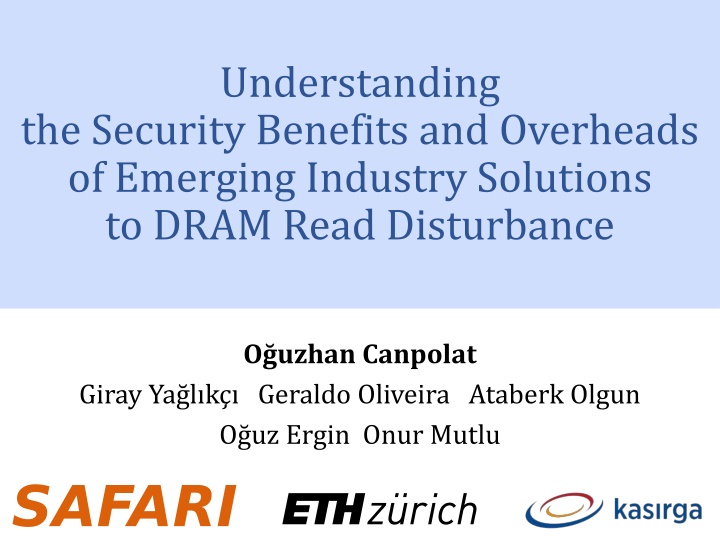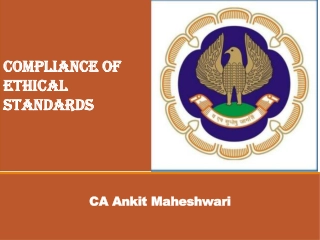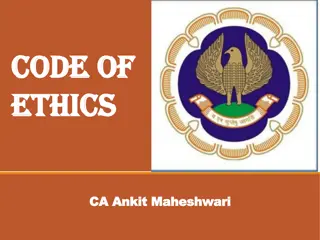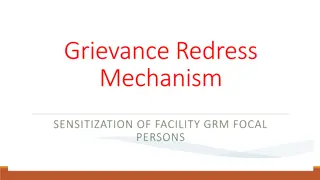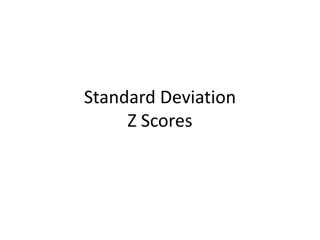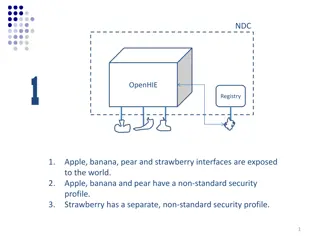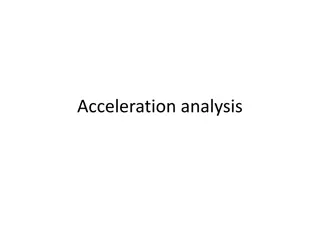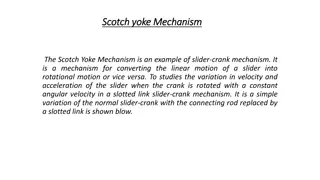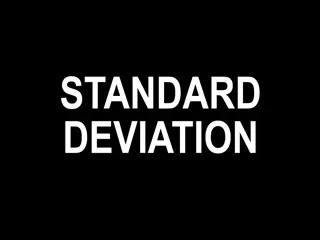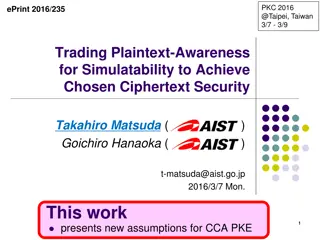Security Implications of DDR5 Standard PRAC Mechanism
"Analysis of security and performance impact of DDR5 standard's Per-Row Activation Counting (PRAC) mechanism, showing it provides security against bitflips (under 10 activations) but incurs significant performance and energy overheads. PRAC allows memory performance attacks to exploit DRAM throughput."
Download Presentation

Please find below an Image/Link to download the presentation.
The content on the website is provided AS IS for your information and personal use only. It may not be sold, licensed, or shared on other websites without obtaining consent from the author.If you encounter any issues during the download, it is possible that the publisher has removed the file from their server.
You are allowed to download the files provided on this website for personal or commercial use, subject to the condition that they are used lawfully. All files are the property of their respective owners.
The content on the website is provided AS IS for your information and personal use only. It may not be sold, licensed, or shared on other websites without obtaining consent from the author.
E N D
Presentation Transcript
Understanding the Security Benefits and Overheads of Emerging Industry Solutions to DRAM Read Disturbance O uzhan Canpolat Giray Ya l k Geraldo Oliveira Ataberk Olgun O uz Ergin Onur Mutlu
Executive Summary Problem: DRAM continues to become more vulnerable to read disturbance Latest update (April 2024) to DDR5 standard introduces Per Row Activation Counting (PRAC) to mitigate read disturbance No prior work investigates PRAC ssecurity and performance Goal: Rigorously analyze and characterize the security and performance implications of the DDR5 standard PRAC mechanism Mathematical analysis & extensive simulations show that PRAC: provides security as long as no bitflip occurs below 10 activations has non-negligible performance (10%) andenergy (18%) overheads poorly scales for future DRAM chips, leading to significant overheads on performance (49%)and energy (136%) allows memory performance attacks to hog significant amount of DRAM throughput (up to 79% throughput loss) https://github.com/CMU-SAFARI/ramulator2 2
Outline Background Industry Solutions to Read Disturbance Security Analysis Performance and Energy Evaluation Memory Performance Attacks Conclusion 3
DRAM Organization DRAM Chips DRAM Channel DRAM Module 4
DRAM Organization DRAM Cell Bitline DRAM Array Wordline Bank S S S S Sense amplifiers (row buffer) Off-chip channel 5
DRAM Operations 1 ACTIVATE: Fetch the row into the row buffer 1 1 1 1 2 READ/WRITE: Retrieve or update data 3 PRECHARGE: Prepare the array for a new ACTIVATE to I/O ACTIVATION and PRECHARGE are time-consuming operations 6
DRAM Access Latency ACTIVATE PRECHARGE Command Data Duration Next ACT row-cycle time (tRC) 7
RowHammer: A Prime Example of Read Disturbance DRAM Subarray Victim Row Row 0 Row 0 Row 1 Row 1 Row 1 Victim Row open closed open open closed Row 2 Row 2 Row 2 Row 2 Row 2 Row 2 Aggressor Row Row 3 Row 3 Row 3 Victim Row Row 4 Row 4 Victim Row Repeatedly opening (activating) and closing (precharging) a DRAM row causes read disturbance bitflips in nearby cells 8 [Kim+ ISCA 20]
Read Disturbance Vulnerabilities (I) DRAM Subarray Victim Row Row 0 Row 0 Row 1 Row 1 Row 1 Victim Row open closed open open Row 2 Row 2 Row 2 Row 2 Row 2 Aggressor Row Row 3 Row 3 Row 3 Victim Row Row 4 Row 4 Victim Row The minimum number of activations that causes a bitflip is called the RowHammer threshold (NRH) 9 [Kim+ ISCA 20]
Read Disturbance Vulnerabilities (II) DRAM chips are more vulnerable to read disturbance today Read disturbance bitflips occur at much lower activation counts (more than two orders of magnitude decrease in less than a decade): <1K (RowPress) [Luo+, ISCA 23] 139K 9.6K [Kim+, ISCA 14] [Kim+, ISCA 20] It is critical to prevent read disturbance bitflips effectively and efficiently for highly vulnerable systems 10
Existing RowHammer Mitigations (I): Preventive Refresh DRAM Subarray Victim Row Row 0 Row 0 Row 0 Row 1 Row 1 Row 1 Row 1 Victim Row open closed open open Row 2 Row 2 Row 2 Row 2 Row 2 Row 2 Aggressor Row Aggressor Row Row 3 Row 3 Row 3 Row 3 Victim Row Row 4 Row 4 Row 4 Victim Row Refreshing potential victim rows mitigates RowHammer bitflips 11 [Kim+ ISCA 20]
Existing RowHammer Mitigations (II): DRAM Aggressor Row Tracking or Estimation DRAM Subarray Victim Row Row 0 Row 0 Row 0 Row 1 Row 1 Row 1 Row 1 Victim Row open closed open open Row 2 Row 2 Row 2 Row 2 Row 2 Row 2 Aggressor Row Aggressor Row Row 3 Row 3 Row 3 Row 3 Victim Row Row 4 Row 4 Row 4 Victim Row Necessary to accurately track or estimate aggressor DRAM row activation counts to preventively refresh potential victim rows 12 [Kim+ ISCA 20]
Outline Background Industry Solutions to Read Disturbance Security Analysis Performance and Energy Evaluation Memory Performance Attacks Conclusion 13
Industry Solutions to Read Disturbance: When To Refresh? (I) Preventive refresh is a blocking operation ACT DRAM Channel DRAM Module Memory controller could cause faulty operation by accessing the memory module during refresh 14
Industry Solutions to Read Disturbance: When To Refresh? (II) Earlier JEDEC DDR5 specifications introduce Refresh Management (RFM) commands RFM DRAM Channel DRAM Module Memory controller sends an RFM command to allow time for preventive refreshes 15
Industry Solutions to Read Disturbance Periodic Refresh Management (PRFM) Periodic Refresh Management (PRFM) Memory controller periodically issues RFM commands Memory controller periodically issues RFM commands Per Row Activation Counting and Back-Off (PRAC) DRAM chip tracks row activations and requests RFMs by sending back-off signals 16
Industry Solutions to Read Disturbance: Periodic Refresh Management (PRFM) ACT RFM Bank Activation Counters 0 0 1 2 3 0 0 0 0 PRFM tracks activations with low accuracy, RFM Threshold causing high number of preventive refreshes, leading to large performance and energy overheads ACT ACT ACT RFM DRAM Commands 17
Industry Solutions to Read Disturbance Periodic Refresh Management (PRFM) Memory controller periodically issues RFM commands Per Row Activation Counting and Back-Off (PRAC) DRAM chip tracks row activations and requests RFMs by sending back-off DRAM chip tracks row activations and requests RFMs by sending back-off Per Row Activation Counting and Back-Off (PRAC) 18
Industry Solutions to Read Disturbance: Per Row Activation Counting DRAM Rows Counters 0 0 101010101010101010101010 0 1 2 3 4 0 101010101010101010101010 0 101010101010101010101010 0 PRAC allows accurate tracking of aggressor row activations 19
Industry Solutions to Read Disturbance: Per Row Activation Counting DRAM Timings DRAM Rows Counters 0 101010101010101010101010 0 101010101010101010101010 0 101010101010101010101010 0 101010101010101010101010 0 101010101010101010101010 Row counter updates are not completely parallelized with DRAM access PRACincreases row-cycle time (tRC) by ~10% row-cycle time (tRC) ACT ACT 20
Industry Solutions to Read Disturbance: Per Row Activation Counting DRAM Timings Timing parameter changes for DDR5-3200AN speed bin [JEDEC JESD79-5C, April 2024] tRP tRAS tRTP tWR tRC : +21ns (+140%) (-50%) : -16ns (-33%) : -2.5ns (-66%) : -20ns (+10%) : +5ns 21
Industry Solutions to Read Disturbance: Per Row Activation Counting (PRAC) Back-Off ACT RFM Row Counters 0 Back-Off Threshold 0 1 2 3 4 0 0 recovery (N RFMs) normal traffic (180 ns) PRAC-N ACT ACT ACT ACT RFM RFM DRAM Commands 22
Outline Background Industry Solutions to Read Disturbance Security Analysis Performance and Energy Evaluation Memory Performance Attacks Conclusion 23
Mathematical Security Analysis Methodology Wave attack [Ya l k +, 2021] :worst-case access pattern maximizes hammer count by using decoy rows on a system with PRFM on a system with PRAC Parameters: Starting row set size: # of rows that the wave attack hammers RFM threshold (PRFM) Back-Off threshold (PRAC) Result: Worst possible (highest) activation count that an attacker can achieve to a row 24
Security Analysis: Secure PRFM Configurations Wave Attack Parameter Highest activation count an attacker can achieve Higher is worse Defense Parameter 25
Security Analysis: Secure PRFM Configurations Wave Attack Parameter Highest activation count an attacker can achieve Unsafe RowHammer Threshold = 1024 Higher is worse Safe Defense Parameter 26
Security Analysis: Secure PRFM Configurations Highest activation count an attacker can achieve Higher is worse 27
Security Analysis: Secure PRFM Configurations Highest activation count an attacker can achieve Higher is worse PRFM must send RFM commands very frequently (every ~8 ACTs) to prevent bitflips at low RowHammer thresholds (below 128) 28
Security Analysis: Secure PRAC Configurations Highest activation count an attacker can achieve Higher is worse Less frequent back-off signals 29
Security Analysis: Secure PRAC Configurations Highest activation count an attacker can achieve Higher is worse Less frequent back-off signals PRAC is configurable for secure operation against RowHammer thresholds as low as 10 30
Outline Background Industry Solutions to Read Disturbance Security Analysis Performance and Energy Evaluation Memory Performance Attacks Conclusion 31
Evaluation Methodology Performance and energy consumption evaluation: cycle-level simulations using Ramulator 2.0 [Luo+, CAL 2023] and DRAMPower [Chandrasekar+, DATE 2013] System Configuration: Processor 4 cores, 4.2GHz clock frequency, 4-wide issue, 128-entry instruction window DRAM DDR5, 1 channel, 2 rank/channel, 8 bank groups, 4 banks/bank group, 64K rows/bank Memory Ctrl. 64-entry read and write requests queues, Scheduling policy: FR-FCFS with a column cap of 4 Last-Level Cache 8 MiB (4-core) Comparison Points: 3 state-of-the-art RowHammer mitigations Best-performing: Graphene [Park+ 2020] Lowest processor chip area: PARA [Kim+ 2014] Area-optimized best-performing: Hydra [Qureshi+ 2022] Workloads: 60 4-core workload mixes SPEC CPU2006, SPEC CPU2017, TPC, MediaBench, YCSB 32
Performance Comparison: Industry Solutions 1 PRFM Memory controller periodically issues RFM 2 PRAC-N Memory controller issues N RFMs each with back-off 3 PRAC+PRFM Memory controller issues RFM periodically and with back-offs 4 PRAC-Optimistic PRAC-4 with no change in DRAM timing parameters 33
Experimental Results: Performance Overhead and Its Scaling Higher is better Lower is worse 34
Experimental Results: Performance Overhead and Its Scaling 10% PRAC has non-negligible performance overhead (10%) due to increased access latency 35
Experimental Results: Performance Overhead and Its Scaling Graphene and Hydra outperform PRAC at relatively high NRH values 36
Experimental Results: Performance Overhead and Its Scaling Above NRH of 32, PRAC overhead only slightly increases due to timely preventive refreshes Below NRH of 32, PRAC overhead significantly increases due to conservative thresholds against a wave attack 37
Experimental Results: Performance Overhead and Its Scaling PRAC-Optimistic outperforms all evaluated mitigation mechanisms (above NRH of 32) 38
Experimental Results: Performance Overhead and Its Scaling PRFM s system performance overheads significantly increase (by 37x) as NRH decreases 39
Experimental Results: DRAM Energy Overhead and Its Scaling Higher is worse Lower is worse 40
Experimental Results: DRAM Energy Overhead and Its Scaling 18% PRAC has non-negligible DRAM energy overhead (18%) due to increased timing parameters 41
Experimental Results: DRAM Energy Overhead and Its Scaling Above NRH of 32, PRAC overhead only slightly increases due to timely preventive refreshes Below NRH of 32, PRAC overhead significantly increases due to conservative thresholds against a wave attack 42
Experimental Results: DRAM Energy Overhead and Its Scaling 33x PRFM s DRAM energy overhead significantly increase (to 33x) as NRH decreases 43
Outline Background Industry Solutions to Read Disturbance Security Analysis Performance and Energy Evaluation Memory Performance Attacks Conclusion 44
Memory Performance Attacks Access pattern to trigger most back-offs with fewest activations possible by targeting a single row Row Counters Adversarial Access Pattern 0 0 Many Back-Offs Mathematically hogs up to 79% of DRAM throughput of future DRAM chips Degrades system performance by up to 65% (53% on average) 45
More in the Paper Detailed Background More information on PRAC and RFM Security Analysis Threat Model Secure Configurations Evaluation Storage Analysis: PRAC and PRFM incur low storage overheads and scale well with decreasing NRH values Memory Performance Attacks Simulation results between NRH values of 128 and 16 46
More in the Paper https://arxiv.org/abs/2406.19094 47
Open Sourced https://github.com/CMU-SAFARI/ramulator2 48
Outline Background Industry Solutions to Read Disturbance Security Analysis Performance and Energy Evaluation Memory Performance Attacks Conclusion 49
Conclusion Werigorously analyzed and characterized the security and performance implications of recently introduced industry solutions to DRAM read disturbance Mathematical analysis & extensive simulations show that PRAC: provides security as long as no bitflip occurs below 10 activations has non-negligible performance (10%) andenergy (18%) overheads poorly scales for future DRAM chips, leading to significant overheads on performance (49%)and energy (136%) allows memory performance attacks to hog significant amount of DRAM throughput (up to 79% throughput loss) Future work: More research is needed to improve PRAC by reducing the overheads due to increased DRAM timing parameters solving the exacerbated performance impact as NRH decreases stopping preventive refreshes from being exploited by memory performance attacks 50
